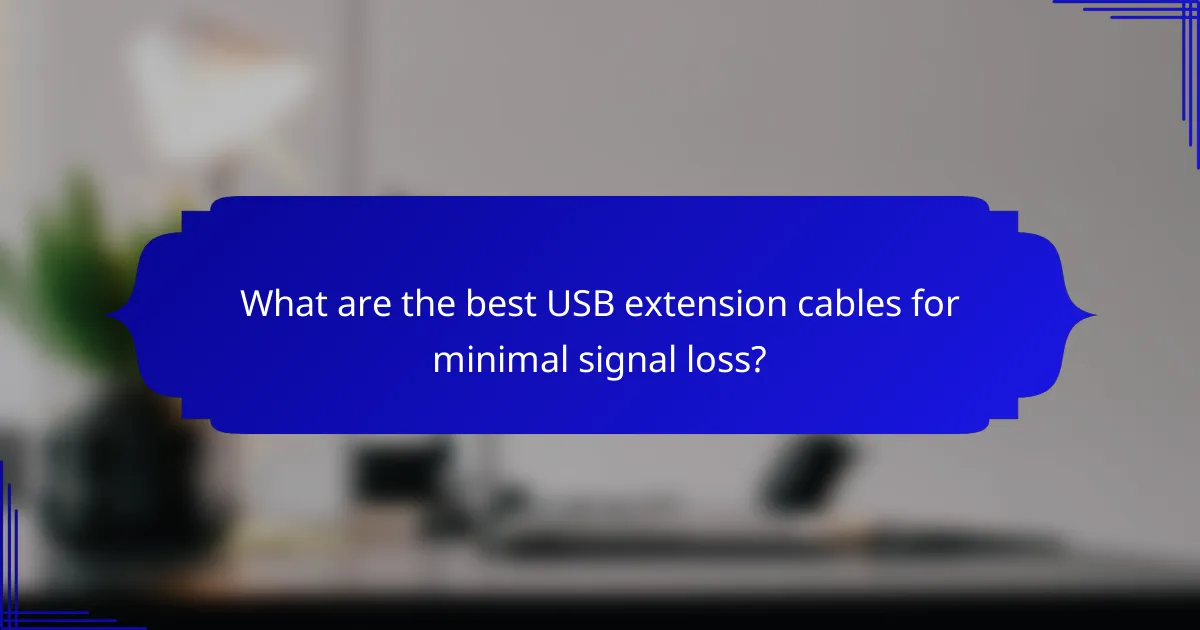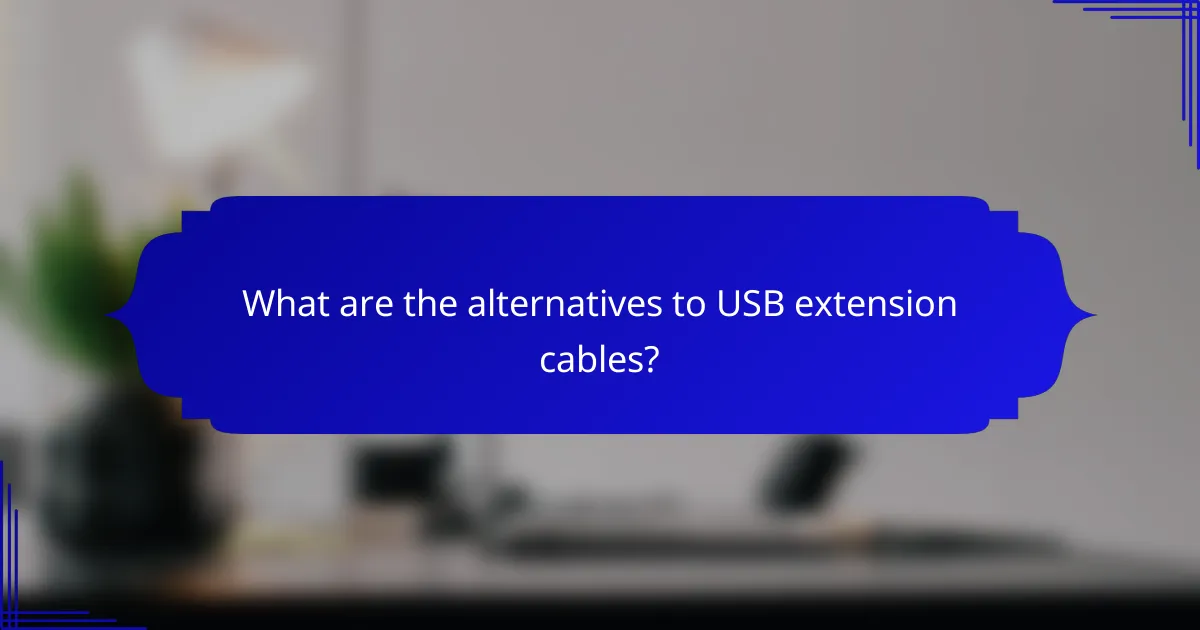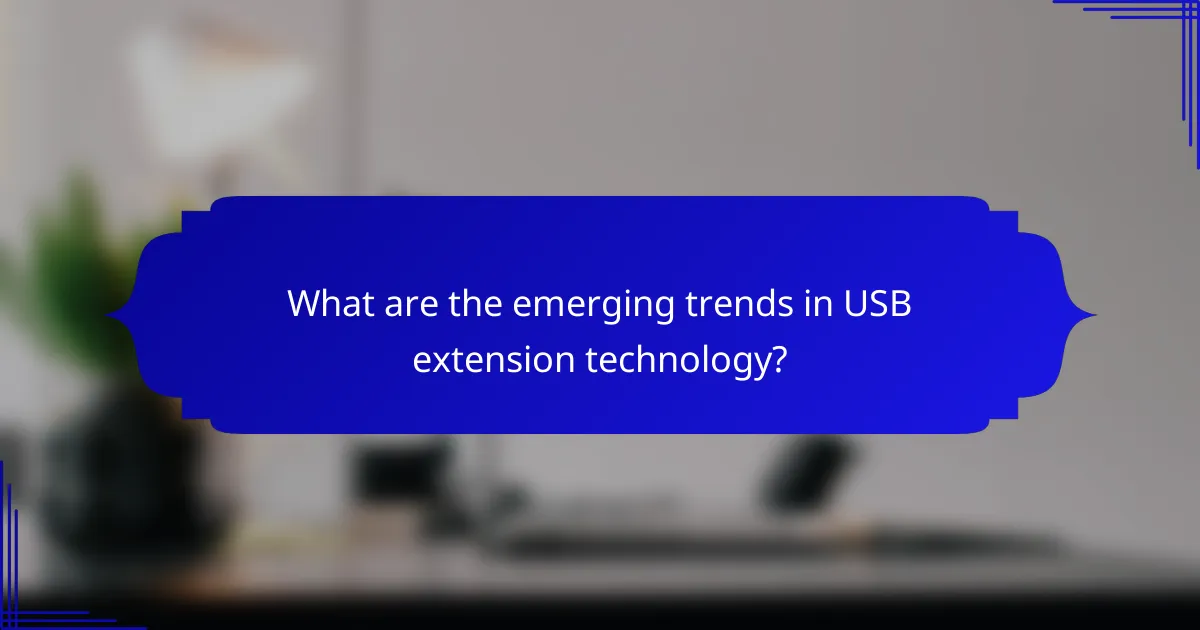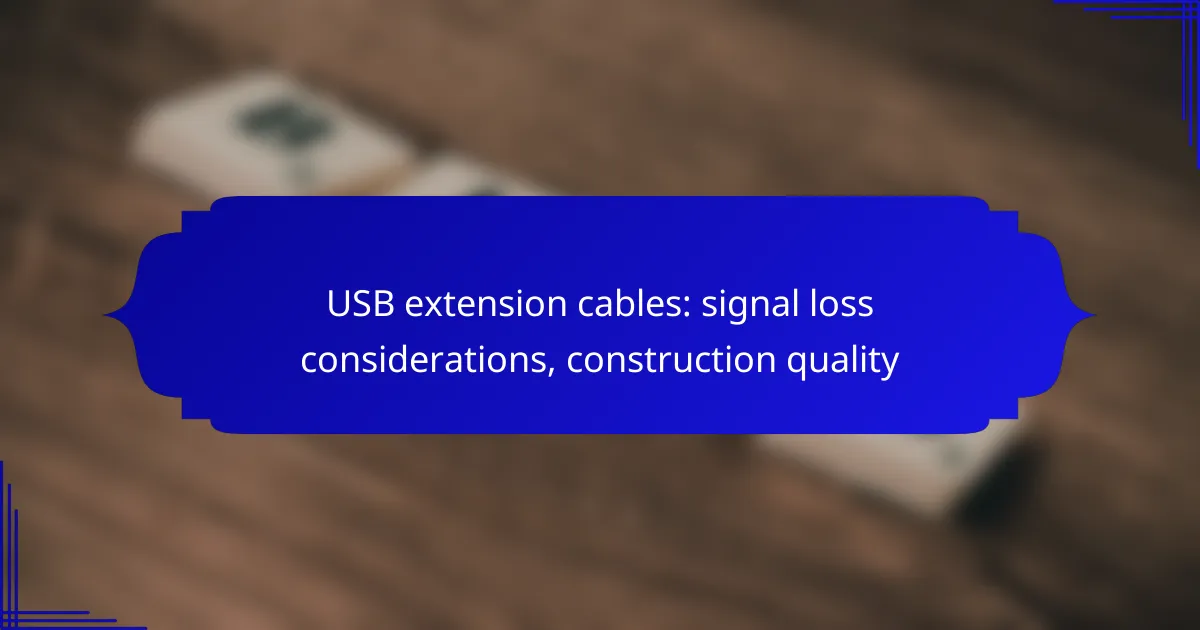When selecting USB extension cables, it’s crucial to consider signal loss, which can be influenced by cable length and the USB standard in use. High-quality construction, including proper shielding and cable gauge, plays a vital role in maintaining signal integrity and ensuring reliable performance. Opting for cables that support USB 3.0 or higher can significantly reduce interference and enhance overall functionality.

What are the best USB extension cables for minimal signal loss?
The best USB extension cables for minimal signal loss are those that adhere to high-quality construction standards and utilize appropriate materials. Look for cables that support USB 3.0 or higher, as they are designed to minimize interference and maintain signal integrity over longer distances.
AmazonBasics USB 3.0 Extension Cable
The AmazonBasics USB 3.0 Extension Cable is a reliable choice for extending USB connections with minimal signal degradation. It supports data transfer speeds up to 5 Gbps, making it suitable for high-bandwidth devices like external hard drives and webcams.
This cable is available in various lengths, typically ranging from 0.5 meters to 3 meters. When selecting a length, consider that longer cables may introduce slight signal loss, so choose the shortest length that meets your needs.
Anker USB 3.0 Extension Cable
Anker’s USB 3.0 Extension Cable is known for its durable construction and efficient signal transmission. It features a robust design that includes gold-plated connectors, which help reduce corrosion and maintain a strong connection.
This cable also supports data transfer speeds up to 5 Gbps and is available in lengths from 0.9 meters to 3 meters. Users appreciate its flexibility and reliability, making it a popular option for both home and office use.
Cable Matters USB Extension Cable
Cable Matters offers a USB Extension Cable that balances quality and affordability. This cable is designed to support USB 3.0 speeds, ensuring minimal signal loss during data transfer.
Available in lengths from 1 meter to 5 meters, it is important to note that while longer cables can be convenient, they may experience more signal degradation. For optimal performance, consider using a cable length that is as short as possible for your setup.

How does construction quality affect USB extension cables?
The construction quality of USB extension cables significantly influences their performance and reliability. Factors such as shielding, cable gauge, and overall build can determine the extent of signal loss and the durability of the cable over time.
Importance of shielding in construction
Shielding in USB extension cables serves to protect the signal from electromagnetic interference (EMI) and radio frequency interference (RFI). High-quality cables often feature multiple layers of shielding, which can include foil and braided materials, reducing the risk of signal degradation.
When choosing a USB extension cable, look for options with good shielding, especially if you plan to use the cable in environments with many electronic devices. Poorly shielded cables can lead to noticeable signal loss, impacting data transfer speeds and overall performance.
Impact of cable gauge on performance
The gauge of a USB extension cable refers to its thickness, which directly affects its resistance and, consequently, the signal quality. A lower gauge number indicates a thicker cable, which typically results in better performance by minimizing resistance and reducing signal loss over longer distances.
For optimal performance, especially over longer runs, consider using cables with a gauge of 24 AWG or lower. Cables with higher gauge numbers may work for shorter distances but can lead to significant signal degradation when extended beyond a few meters.

What are the common causes of signal loss in USB extension cables?
Signal loss in USB extension cables can occur due to several factors, primarily related to cable length and the type of USB standard used. Understanding these causes can help you select the right cable for your needs and minimize performance issues.
Length of the cable
The length of a USB extension cable significantly affects signal integrity. Generally, longer cables tend to experience more signal degradation due to resistance and electromagnetic interference. For USB 2.0, the maximum recommended length is about 5 meters, while USB 3.0 cables should ideally not exceed 3 meters to maintain optimal performance.
When using longer cables, consider using active USB extension cables, which contain built-in signal boosters to help maintain signal quality over greater distances. This can be particularly useful in setups where devices are far apart.
Type of USB standard used
The type of USB standard can greatly influence the potential for signal loss. USB 2.0 supports data rates up to 480 Mbps, while USB 3.0 can handle up to 5 Gbps. Using a USB 3.0 extension cable with a USB 2.0 device may not yield the best performance, as the cable’s capabilities may not be fully utilized.
Additionally, different USB standards have varying tolerances for signal loss. USB 3.0 and above are designed to handle more data and are less susceptible to interference compared to older standards. Always match your cable type with your devices to ensure compatibility and optimal performance.

How to choose the right USB extension cable?
Choosing the right USB extension cable involves considering factors like length, construction quality, and device compatibility. These elements significantly impact performance, signal integrity, and overall usability.
Consider cable length and application
The length of a USB extension cable directly affects signal quality. Generally, for USB 2.0, lengths up to 5 meters are acceptable without significant signal loss, while USB 3.0 cables should ideally be kept under 3 meters. If longer distances are necessary, consider using active extension cables that amplify the signal.
Think about your specific application as well. For instance, if you need to connect a device in a different room, a longer cable may be required, but ensure it meets the necessary standards to maintain performance.
Evaluate connector quality
Connector quality is crucial for ensuring a reliable connection. Look for cables with gold-plated connectors, as they resist corrosion and provide better conductivity. Poor-quality connectors can lead to intermittent connections and signal degradation.
Inspect the build quality of the connectors as well. A sturdy, well-constructed connector will withstand repeated plugging and unplugging, which is especially important for frequently used devices.
Check for compatibility with devices
Ensure that the USB extension cable is compatible with your devices. Different USB versions (like USB 2.0, 3.0, or 3.1) have varying data transfer rates and power delivery capabilities. Using a USB 3.0 cable with a USB 2.0 device will work, but you won’t benefit from the higher speeds.
Additionally, check if the cable supports the specific features of your devices, such as fast charging or data transfer rates. This will help you avoid performance issues and ensure optimal functionality.

What are the alternatives to USB extension cables?
Alternatives to USB extension cables include active USB extension cables and USB hubs with extended reach. These options can help maintain signal quality over longer distances without the drawbacks of passive extensions.
Active USB extension cables
Active USB extension cables use built-in electronics to boost the signal, allowing for longer distances without significant loss of data integrity. They can typically extend USB connections up to 30 meters or more, depending on the cable quality and specifications.
When choosing an active USB extension cable, consider the USB version you need, as USB 3.0 and above require higher quality components to maintain performance. Look for cables that are well-reviewed and specify their maximum length to avoid issues with signal degradation.
USB hubs with extended reach
USB hubs with extended reach allow multiple devices to connect to a single USB port while maintaining a reasonable distance from the computer. These hubs can be powered or unpowered, with powered hubs providing additional power to connected devices, which can be beneficial for high-draw peripherals.
When selecting a USB hub, check the number of ports and whether it supports the USB version you require. Additionally, consider the hub’s power supply, as powered hubs can help prevent issues with devices that require more power than the standard USB port can provide.

What are the best practices for using USB extension cables?
To effectively use USB extension cables, prioritize minimizing signal loss and ensuring high construction quality. Following best practices will help maintain performance and longevity of your devices.
Avoid excessive lengths
When using USB extension cables, keep the length as short as possible. Generally, lengths exceeding 5 meters can lead to significant signal degradation, especially for USB 2.0 connections. For USB 3.0, the maximum recommended length is around 3 meters to avoid performance issues.
Longer cables can introduce latency and reduce data transfer speeds. If you need to cover greater distances, consider using multiple shorter cables connected with high-quality connectors instead of one long cable.
Use powered USB hubs for longer distances
For setups requiring longer distances, powered USB hubs are a practical solution. These hubs provide additional power to connected devices, which helps maintain signal integrity over longer runs. They can effectively extend the reach of USB connections beyond standard limits.
When selecting a powered hub, ensure it complies with the USB standard relevant to your devices, such as USB 2.0 or USB 3.0. This will help ensure compatibility and optimal performance.

What are the emerging trends in USB extension technology?
Emerging trends in USB extension technology focus on enhanced performance, convenience, and integration with modern devices. Key developments include the adoption of USB 4.0 standards, the rise of wireless USB solutions, and greater compatibility with smart home devices.
Adoption of USB 4.0 standards
The adoption of USB 4.0 standards marks a significant advancement in USB extension technology, offering higher data transfer speeds and improved power delivery. USB 4.0 can support speeds up to 40 Gbps, allowing for faster connections and reduced latency.
When considering USB extension cables, look for those that explicitly state compatibility with USB 4.0 to ensure optimal performance. This is particularly important for applications requiring high bandwidth, such as video streaming or data-intensive tasks.
Development of wireless USB solutions
Wireless USB solutions are gaining traction as they eliminate the need for physical cables, providing greater flexibility and convenience. These solutions use technologies like Wi-Fi or Bluetooth to transmit data, making it easier to connect devices without clutter.
However, users should be aware of potential limitations in range and speed compared to wired connections. Wireless USB may be suitable for less demanding applications, but for high-speed data transfers, wired connections remain preferable.
Integration with smart home devices
As smart home technology evolves, USB extension solutions are increasingly integrated with various smart devices. This integration allows for seamless connections between devices such as smart speakers, cameras, and hubs, enhancing overall functionality.
When selecting USB extension cables for smart home applications, prioritize cables that support the latest standards and offer robust construction to withstand frequent use. This ensures reliable performance and longevity in a dynamic home environment.
